THE Great Artesian Basin Sustainability Initiative
(GABSI) is hailed by many as the most beneficial project ever provided to Australian agriculture.
Since its inception 20 years ago, the upgrading of more than 750 free-flowing bores and the installing of almost 32,000km of pipe drains has resulted in massive annual water savings of 250 gigalitres for one of the world’s largest underground freshwater resources.
Before the capping and piping of the bores, up to 95% of Great Artesian Basin (GAB) water was being wasted through evaporation and seepage in free-flowing drains – which has been a problem ever since commercial exploitation of the Basin’s water and pressure resources began in 1878.
In NSW the initiative, implemented in this state as the
Cap and Pipe the Bores Program, has overseen the capping of 398 free-flowing bores, with more than 10,000km of bore drains removed and 18,000km of pipe installed. That adds up to a saving of 78,500 megalitres of water every year and about 4.2 million hectares of farms supplied with permanent, efficient and strategically-located watering points.
The program has been blessed with many glowing names, but the title of unsung drought hero is the most apt for Ranald Warby, who farms at Mungindi on the NSW/Queensland border. Ranald and wife Noela produce wool, lamb and dryland grains on their 4,000-hectare property Barrakee, which is now entirely dependent on piped groundwater after two years of drought.
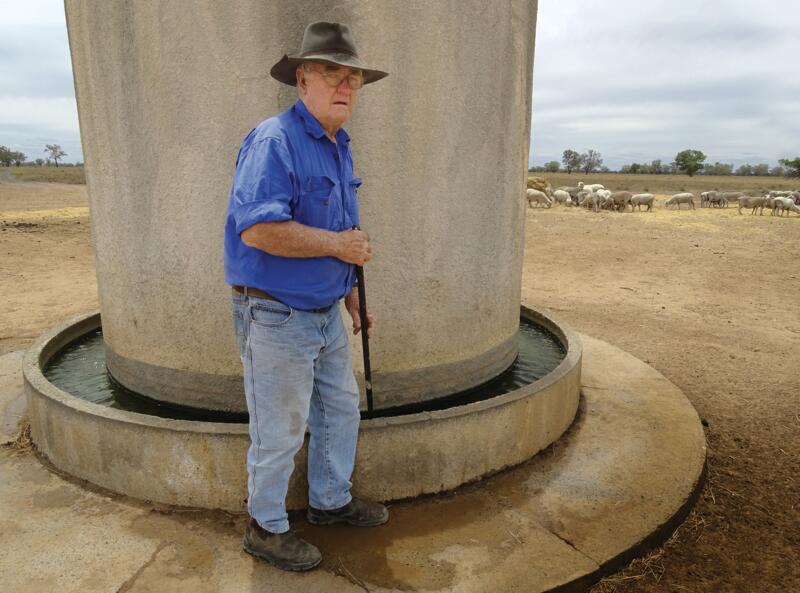 Mungindi farmer Ranald Warby with a tank and livestock trough constructed as part of his property’s bore-capping project. Source: supplied.
Mungindi farmer Ranald Warby with a tank and livestock trough constructed as part of his property’s bore-capping project. Source: supplied.
“Our bore is part of a trust that has 17 trustees or landholders, all of whom now have the drought-proofing benefits of the cap and piping program,” Ranald says.
“It gives permanent clean water in two or three troughs in every paddock. We are at the end of the bore drain, and if it had not been capped and piped we would have no water. The dams, creek and river are all basically dry.
“We would definitely have no sheep here at present and that would have been the same for hundreds of properties. Instead, we can spread the sheep widely across every paddock and spread the grazing pressure.”
RELATED ARTICLES ON DROUGHT:
-
Horticulture growers at wits' end with drought
-
Drought-affected crop growers face tough decisions
-
Building resilience to drought
-
Climate change wreaking havoc
Uncapped bores have acted to lower the water pressure in the GAB, which has led to reduced water for pastoral wells and lower environmental flows to natural springs – a situation that has also greatly improved following the cap and pipe work.
“Even the toilets in the house would not be flushing in the current conditions. Most of our house is on GAB water, like most other farm houses on the Basin.” – Ranald Warby
Ranald explains that the trust has the responsibility of delivering the water to farms and the farmer has the job of installing water tanks and delivering it for stock and domestic use. Other than ongoing maintenance costs, the Artesian water is free.
“We capped the old bore, drilled a new one and piped this bore drain in 2000. It initially needed a series of electric pumps to deliver the water, but the pressure has risen in the Basin that much that we have not needed any pumps for five years. We are 25km from the site and there is enough natural pressure to get it there,” he says.
Ranald’s sideline work as a bore trustee has inspired him to help form the
Artesian Bore Water Users Association, and he also represents farmers on federal and state government ministerial committees. GABSI officially came to an end in 2017, and he believes it’s vital for the projects to continue.
“I understand that around 50% of bore drains that have been capped and piped in NSW no longer need pumps to deliver water,” he says.
“But with the rise in the pressure of the Basin, the remaining uncapped bores are flowing at a greater rate which is why the work has to continue.”
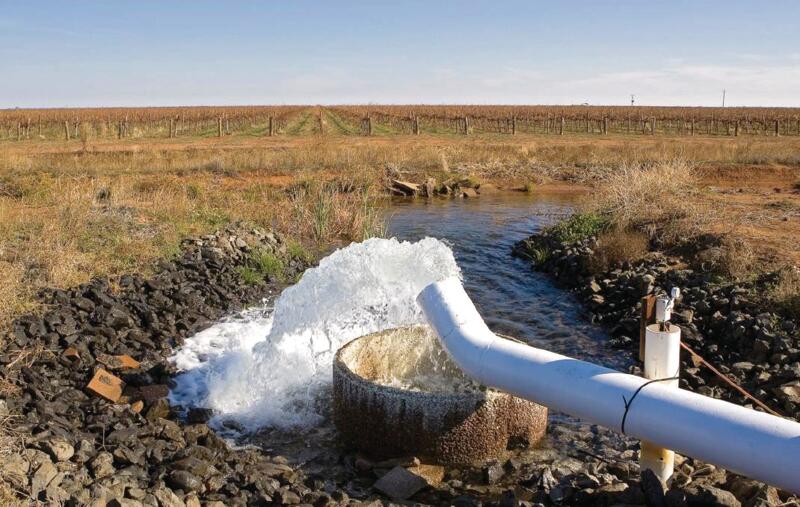 An old-style free-flowing open drain, which wastes most of its water. Source: The Land.
An old-style free-flowing open drain, which wastes most of its water. Source: The Land.
“If governments are serious about drought-proofing Australia, finishing the cap and piping scheme would be a wonderful start.”
Sustaining The Great Artesian Basin a must for farmers
Others agree that there is more to do to sustain this precious resource and realise the full drought-proofing and environmental benefits of a closed system.
“There are still 530 bores to be controlled across the three Basin states, with 229 of them in NSW,” says Juanita Hamparsum, chair of the
Great Artesian Basin Coordinating Committee, which provides advice from community organisations and other agencies to the government on effective Basin management.
She says a Basin-wide coordinated approach to bore rehabilitation was proposed as part of the Great Artesian Basin Strategic Management Plan 2000, and resulted in the development of GABSI. The initiative was delivered in partnership by the Australian, NSW, Queensland, South Australian and Northern Territory governments, as well as Basin landholders, to provide almost $300million in funding to upgrade bore drains.
When GABSI ended in 2017, the federal government announced an $8 million interim package to continue the program through to June this year before embarking on a new long-term funding model.
“It is time to move into the next phase,” Juanita says. “The federal government has committed a further $36.9 million to improve drought resilience by extending the GAB bore-capping program.”
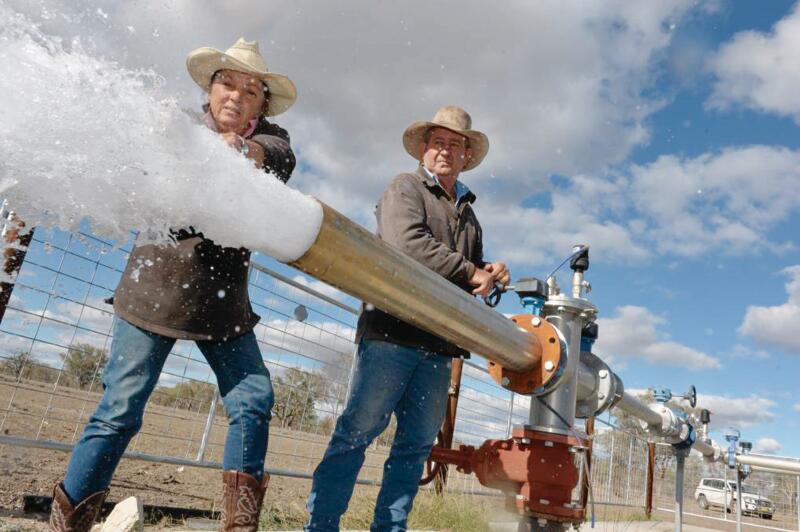 Sue and David Hearn on their property in Brewarrina - the couple had their bore capped and 34km of drains piped with the help of government funding. Source: The Land.
Sue and David Hearn on their property in Brewarrina - the couple had their bore capped and 34km of drains piped with the help of government funding. Source: The Land.
The next five-year phase is set to start this year and will be based on the Draft Great Artesian Basin Strategic Management Plan 2018, which attracted contributions from the industry, government and community.
Meanwhile, the federal government’s drought resilience program funding will be matched by the NSW government, which pledged $26 million towards the next phase prior to the state election. According to the NSW Department of Primary Industries, the investment will see the government partner with locals to boost their drought resilience by capping free-flowing bores and installing new water supply infrastructure such as pipes, tanks and troughs.
Juanita, an irrigation farmer from Gunnedah, says the federal and Basin state governments do recognise that keeping the cap and piping bore program flowing is essential to the health of the GAB and to farming communities. The work will also address environmental issues, as natural flows have been depleted as the pressure dropped.
Capping and piping bores helps regain pressure
“The GAB system operates under pressure, so the water is free-flowing, and there are various fissures or vents where the water naturally comes to surface to form mound springs,” Juanita says.
“There will also be a continued focus on preserving and maintaining mound springs as naturally-occurring ecosystems.
“One of the many benefits of the cap and piping scheme has been significant rises in pressure, particularly in NSW.” – Juanita Hamparsum
The GAB encompasses several geological basins, and over 70% of the bores controlled to date in NSW are located in the Surat Basin, where uncontrolled Artesian flows were the largest prior to the implementation of the capping program. This area has also seen the greatest recovery of Artesian pressure with over 100 kilopascals in the last decade observed in areas north of Coonamble.
“This would have to be the most successful program that government and landholders have ever embarked on in terms of ecological advances, water security and productivity. This is a win-win situation,” Juanita says.
Moree Plains Shire Council Mayor Katrina Humphries agrees, describing the program as an “amazing success” for the North West region. “Many communities and farmers that have invested in capping and piping bores have told me that it has been a saving grace in this drought. It also means that the town of Moree now has secure water supplies for more than 20,000 people and it’s obviously wonderful for our tourism industry,” the Mayor says.
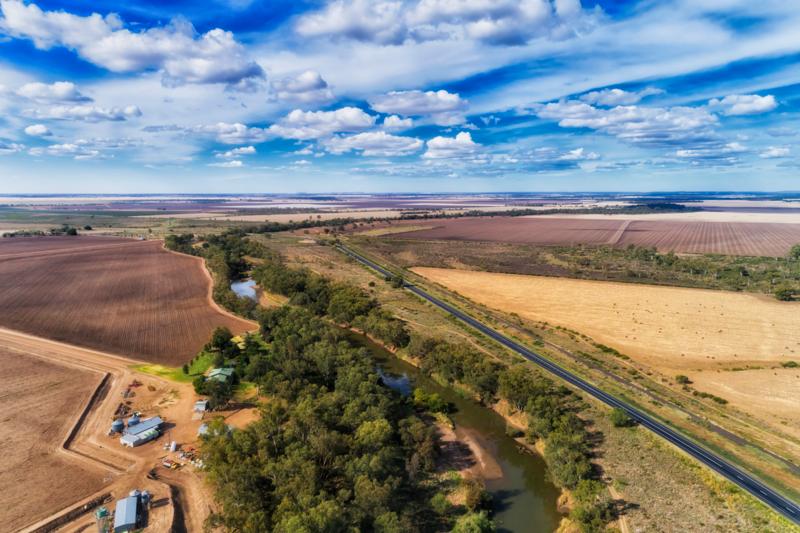 Areas like Moree have seen huge benefits from bore capping. Source: Getty Images.
Areas like Moree have seen huge benefits from bore capping. Source: Getty Images.
“As a community, we are very mindful of our water use and grateful for the secure water supply. This has not been through luck, but through the hard work of those involved in the scheme and the continued maintenance of water infrastructure associated with the Basin.”
According to government reports, more than 120 towns rely on the Basin for water supply, consuming over 40,000 megalitres per year, or 8% of Basin water. The pastoral industry is the largest water user, consuming an estimated 209,000 megalitres per year, or 41% of GAB water extraction. In return, the industry generates more than $4 billion annually in the Basin.
President of the Artesian Bore Water Users Association and Coonamble farmer Anne Kennedy says it’s critical that the integrity of our bores are maintained and that the cap and piping scheme continues.
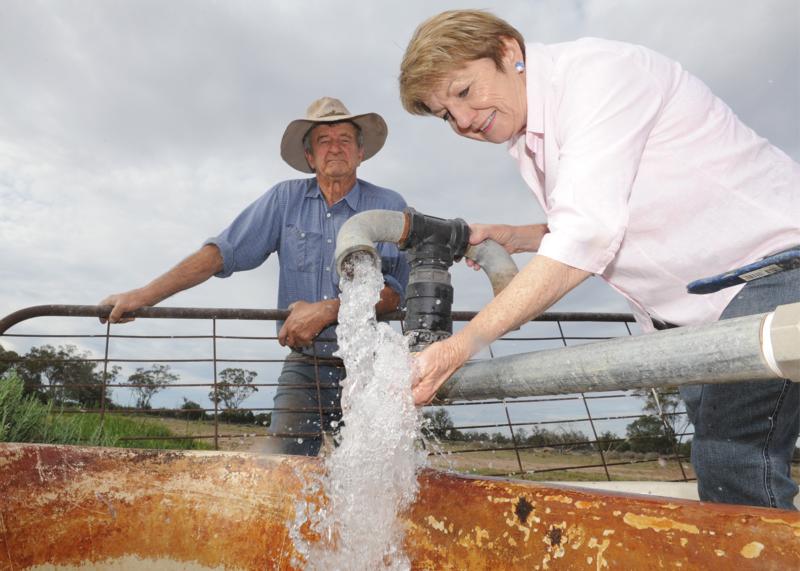 Anne Kennedy and husband Neil at their property in Coonamble. Source: Fairfax
Anne Kennedy and husband Neil at their property in Coonamble. Source: Fairfax
“We have six Artesian bores on our farms – all capped. One of those bores flowed over one million litres a day prior to capping, so the water savings on just one of our farms has been incredible.”
“The most specific benefit of capping and piping is the very fact that we have water. Many communities and farms would not exist without the bore water.”
“Our GAB is the single greatest resource that Australia has. We must preserve it, preserve the pressure and protect it from extractive industries.” – Anne Kennedy